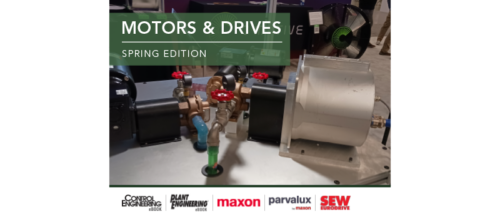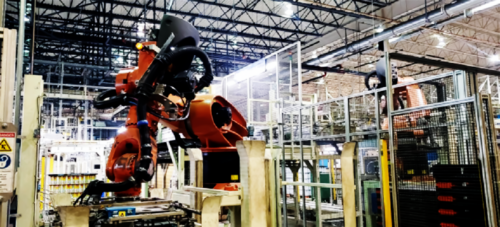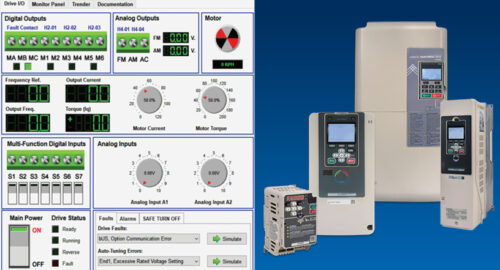Matching motors and drives: Common problems and best practices
While it’s common to use the same manufacturer for a motor or drive, when something breaks down, the choice might not be so straightforward. Knowing what kind of problem and how severe the issue is can help determine what to do next.
Matching motors and drives isn’t always as straightforward as one might expect. It’s not unusual for engineers to run into compatibility issues that can negatively impact timelines or budgets-or both. In a complete motion control overhaul or new build, most engineers work with one manufacturer for both motors and drives. What about repairs, retrofits, and modernization projects?
Maybe the component is obsolete; the lifetime of the part doesn’t match the lifetime of the machine. By replacing one piece, maintaining the machine shouldn’t have a substantial impact on the budget or a lot of downtime. Depending on when the machine was designed, there could be multiple obsolete components, which may require a more extensive modernization plan to improve overall performance.
Another possible situation is the motor is oversized for the application, which was a common practice in the past. Or maybe it’s as simple as something has broken and needs to be fixed to get operations moving again. To ensure a good match for drive replacement, watch out for the following potential issues.
Torque
In a normal, ground-up process, start by choosing the application and selecting a motor designed to meet the specific mechanical and performance needs. From there, select the gearbox and the inverter that suits the motor. The inverter defines peak torque. If the motor is capable of doing more than what the inverter can deliver, the system will be stressed and likely end up damaging the drive.
Figuring out peak torque is straightforward, but when choosing a proper motor size, the root mean square (RMS) torque also should be calculated to consider the varying amounts of torque needed and the amount of time each torque level needs to be produced.
Feedback
For servo and induction motors, also ensure the drive that is chosen can handle the feedback ordered with the motor. If a motor is running at a higher speed and the inverter can’t handle a high frequency, neither component will do the job its being asked to do.
Wiring for motors, drives
If two manufacturers for the motor and drive are being used, something as simple as the wiring connecting the two can create issues. The cables could be purchased from the motor or drive manufacturer, but the problem is they won’t necessarily be standard for the feedback, devices, or phases the application is running. Even the pin outs might differ.
It’s not always obvious when an issue is being caused by a simple wiring mistake, either. With an induction motor, a wiring mistake likely will lead to just counter-directional movement. With a servo motor, however, phases need to be wired correctly or the motion control system won’t work. There could even be permanent damage to the wiring components if the feedback wiring is incorrect. [
Programming, conditioning
Setting up the inverter can be simple. For common induction and linear control, speed control is used, but setup can be challenging. The more dynamic, complex, and higher-performing an application gets, the more difficult it is to ensure all aspects of the motor and drive work in concert.
With open vector control, for example, additional motor characteristics such as resistance ratings are needed. Non-standard motor types might have their own specific requirements. Even induction motors in a vector closed-loop servo control system can achieve precise positioning with the right programming.
Many challenges, one resolution
Most challenges engineers face when matching motors and drives arise when they’re looking at two suppliers. Most manufacturers will at least have documentation on which of their components are compatible with each other and which aren’t, making a mismatch less likely. There are additional benefits of working with one manufacturer to simplify and speed all aspects of the repair or modernization from selection through conditioning.
Some manufacturers offer sizing software that eliminates incompatibility issues and can help optimize for very specific goals, such as up-front cost reduction or long-term energy savings. Advances in systems modeling means being able to compare performance of two products and see how they will act in an application. While they’re usually based on calculated instead of operational values, these models can provide an accurate picture in advance based on values.
With one manufacturer for the motor and drive, the capabilities of each and the suitability for the application are automatically cross-checked while going through the selection process. There’s no need to double check calculations and the selection process is significantly faster.
Getting support for the motion control system also is simplified. There is always uncertainty when working with components from different manufacturers and a risk of finger pointing when something goes wrong. One service team for the motor and drive means there is no passing the buck when technical assistance is needed. Whether it’s a repair, update, or a complete motion control system overhaul, carefully consider the motor and the drive and the ultimate goal before deciding where to source the components.
If a machine needs to get up and running again, it may make sense to order from the original motor or drive manufacturer, whether it matched the other components or not. To improve efficiency and save some time and effort overall, it makes sense to ensure a good match between the motor and drive by seeking out one manufacturer for the best possible results.
Chris Moskaites, product manager – electromechanical solutions, Lenze Americas. Edited by Chris Vavra, production editor, Control Engineering, CFE Media, cvavra@cfemedia.com.
MORE ANSWERS
Keywords: Motors, drives, motor efficiency
- Choosing between motor and drive repair or replacement depends on what needs to be fixed and how expensive it will be overall and goals.
- If a simple repair or part replacement is needed, a quick fix is a better choice than an overhaul.
- Consider an overhaul to a motor and drive if something significant needs to be fixed.
Consider this
What other aspects should be considered when deciding to repair or replace a motor and/or drive?
ONLINE link
https://www.lenze.com/en-us/about-lenze/lenze-in-the-americas/
Do you have experience and expertise with the topics mentioned in this content? You should consider contributing to our CFE Media editorial team and getting the recognition you and your company deserve. Click here to start this process.





